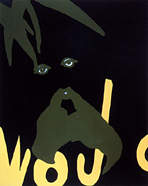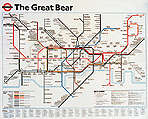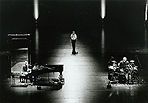
|
|
Dec. 24, 1996
|
Art Watch Index - Dec. 17, 1996
![]()
|
The Turner Prize Awarding Ceremony on November 28, 1996 at 21:00-22:00 broadcast through Channel 4 <<The Works by the Turner Prize Nominees>>
 Douglas Gordon
Douglas Gordon
Douglas Gordon
Gary Hume
Simon Patterson
Craigie Horesfield
The Tate Gallery http://www.illumin.co.uk/ turner/tate.html
Channel 4 / The 1996 Turner Prize
Douglas Gordon Biography
Gary Hume Biography
Gary Hume at the ICA
Damien Hirst
Damien Hirst Biography
Hot Wired: POP | Gallery | Work by Damien Hirst
Rachel Whiteread
Rachel Whiteread - Reference Page
"The Tate Gallery
|
The Turner Prize Announced By the Tate Gallery
On November 28, this year's Turner Prize was awarded to Douglas Gordon. The Turner Prize, organized by the Tate Gallery, is given to the year's most prominent modern artist who is under 50 years old and is living in England, and this will be the 13th award. Because Channel 4, a sponsor of the prize, broadcasts the awarding ceremony as a one-hour live program during prime time, not only the art professionals, but also the general public show high interest in it. The absence of female nominees Prior to the final selection, the list of the 4 prospective winners, Douglas Gordon, Gary Hume, Simon Patterson and Craigie Horesfield was announced. The lineup of the nominees seemed to look reserved compared with last year, when Damien Hirst, the winner, presented a shocking work featuring the bodies of cows, apparently a mother and its calf, cut in half and preserved in liquid formalin. However, when the list was announced, an unpredictable controversy emerged over the fact that no women were nominated. The major media took up this "absence of female nominees", and on the day of the ceremony, a mannequin was found chained to the fence of the Tate Gallery, apparently done by someone protesting the nomination. Also at the ceremony, one of the presenters harshly criticized the "absence of female nominees", revealing a strong opposition towards the selection of candidates. Douglas Gordon or Gary Hume ? We can never tell how much this situation influenced the selection of Douglas Gordon. However, it is quite certain that it slightly affected the minds of the judges who were in charge of the selection. From the early stage, many people expected either Douglas Gordon or Gary Hume to be the winner. In fact, there was much rumor that the Tate Gallery, which is said to be gearing towards conservatism, would select Hume for the "revival of the painting" (naturally, this was also a request from the art market). Therefore, although Gordon was considered to be one of the prospective winners, the result was also unexpected to a certain degree. The first Turner Prize given to a techno-artist There are two reasons for this "unexpected result". One is the fact that this prize had never been given to installation works using film or video, which are the so-called techno-art or video art. Gordon's works included an installation work which used Alfred Hitchcock's movie, "Psycho", turning it into slow-motion, making it run for 24 hours, and a video work, in which Gordon made his right and left arm look like a man's and a woman's respectively, and making them fight on top of the bed. Taking advantage of the fictional aspect of the visual media, he pursues his theme of the "duality" within the human being. Considering the Tate Gallery's past policy of focusing on traditional paintings, drawings and sculptures, Gordon's experimental work using reproductive media, cannot be described as orthodox. In this year's winner selection, one can also see the change in the Tate Gallery's own policy, which is symbolized in their recent addition of the video works by Bill Viola into their collection. The selection of a non-London-based artist after a long interval Another "unexpected" result was the fact that Gordon comes from Glasgow, and still works from that city as his base. In the past few years, the winners were London-based artists such as Rachel Whiteread, Antony Gormley and Damien Hirst, giving an impression that the emphasis was on "Englishness" and not "Britishness". In the English art scene today, because there is an increasing assertion of a slightly nationalistic "Englishness", centering around artists like Hirst, the award given to a Scottish artist was unexpected, but it can be considered a favorable trend. The surprisingly severe controversy over the absence of female nominees revealed that the institution called art can no longer do without the consideration of the issue of genders. However, such criticisms and arguments will open up a new possibility. In terms of making us reflect on the relationship between art and the state, and art and the authority, although ironically, it might have been an unexpected turn for the organizers, this year's Turner Prize could be considered a success.
[Yoshitaka MOURI/Cultural Studies]
|
|
|
|
<<Die Befreiung des Prometheus>>

<<Die Befreiung des Prometheus>> Stage
Saitama Arts Theater http://www.super-nova.co.jp/ hazama/English/ ct_saitama.html
Saitama Arts Theater(Japanese)
People: David Moss
The Berlin Wall Falls
Chris De Witt's Berlin Wall Web Page
Time & Again - Berlin Wall
|
<<Die Befreiung des Prometheus>>
Creating the text of Heiner Muller through sound Goebbels throws stones towards a metal plate. With this sound generated from a physical action as the beginning, various fragments and lumps of sound start to expode. <<Die Befreiung des Prometheus>> (Sai-no-kuni, Saitama Arts Theater), directed by Heiner Goebbels from Germany, who continues his unique activities as a composer, director, and musician, newly created Heiner Muller's text through sound and in relation to sound. Here, what is taken up is the story of Prometheus, who is bound to the deep mountains of Caucasus because he stole fire from the gods and gave it to the humans. He is given the punishment of having his liver eaten by an eagle everyday for thousands of years, and is finally rescued by Hercules. Prometheus goes through an astounding length of time of symbiosis, where he survives through eating the feces of the eagle who ate his own liver, and there is increasing, dreadful filth and stench. That stench also becomes one of the difficulties for Hercules when he challenges to rescue him. That difficulty in that scene, according to Goebbels's analysis, is structurally woven into Muller's text, and even for the German audience, immediate understanding of the content is said to be difficult (in Japan, the audience are given the translation of the text to refer to). How should we understand the endless distance of disgrace in Muller's text emphasized especially by Goebbels? After the rain, which continued for five hundred years, alleviated the stench, Hercules is able to come closer to the shooting range of his bow, kills the eagle and frees Prometheus. However, Prometheus laments the death of the eagle, and abuses the emancipator. The sound and text which move while crossing boundaries The stage is very simple. Goebbels freely utilizes electronic sounds from various methods mainly focusing on the keyboard. He not only incorporates drum sounds, the sound of throwing beans, and the sound of aluminum foil as sound sources, but there is also David Moss, who with his transcendental voice, creates explosive and frictional sound using himself as an instrument. With those sounds, he creates distance from specific meaning or person, and opens up towards multiplicity. Ernst Stötzner mechanically recites the emotional and humourous text using a microphone, as he walks around the stage. Here, there is no separation between the musical performance and the actors, and the sound and text are born from the same place. Even with the sound, it is sometimes fragmental, continuous or colliding, and sometimes crossing over to various styles such as rock, jazz or film music. The text is launched into the space not only as words, but as parole using a loudspeaker. The musician/actor and the sound/text constantly move while crossing borders. The work as a critique/question Here, Prometheus, who is an interface between the gods and the humans, also appears as an ambivalent existence. This is recognized in his identification with the eagle through extreme agony and stench, in other words, attachment created by oppression, and the contradiction of the resulting pain from losing that attachment through the "violence" called freedom. It is also possible to interpret this in the context of the German unification. From the play-within-the-play, <<Zement>>, which was a work written by Muller in 1972, Goebbels created his work in 1990, immediately after the fall of the Berlin Wall. What is the meaning of Goebbels, coming from the post-war generation of West Germany, performing at around the time of the unification, the work by Muller, who was an anti-establishment activist from East Germany? The answer could be, the struggle which lost the target of the struggle, or that the target of the struggle is no longer in the external, but has become an inernalized struggle or a questioning of the struggle itself. Needless to say, this work is one of a critique/question. Of course, even this method of amputated criticism can become habitualized and stylized. However, the text as sound can avoid the tempation towards such a metaphor, and even achieve flotation. It is very painful to see why such a layered reading of the text, and the method of brilliant cunning where the existing stage setting (such as the catwalk and the backyard), which seems to conflict with the reading, is easily incorporated, cannot be seen in the Japanese theater scene. [Yukiko SHIKATA/Art Critic]
|
|
|
|
"Strange Kinoko Dance Co./I phoned and I slipped"
Michael Jackson Internet Fan Club HomePage http://www.fred.net/mjj/
The Legend Continues - Michael Jackson Fanclub
Welcome To HIStory!
Jamiroquai
Jamiroquai Articles Archive
|
Why Are "Things Besides Dance" Interesting?
Is the dance really interesting??? It seems that a symposium titled "Is the dance really interesting?" is going to be held. My answer to that question is - "The recent dance is not interesting as long as it is in the field of dance". The form called "dance", the medium called "dance", the name (designation) called "dance" - it is difficult to understand the reason why they select the word... That is what I strongly felt from the "Strange Kinoko Dance Co./I phoned and I slipped." Is everything groovy considered to be dance? Actually, in the pamphlet of this performance, a discussion between the Kinokos, myself, and another playwright is included. It is certainly true that I feel such a pop group like this company should be protected because they are necessary for the current Japanese dance scene. Dance must have groove. Everything groovy should be called "dance". In those terms, their courage of "enjoying doing silly things" should be evaluated. In their performance, "Rydeen, the Brave" (called so by herself) (NB: "Rydeen" is a TV SF animation character in Japan, popular in the '70's) appeared, and her dance, where she was wrapped in a stuffed suit and "could not move very well", was very groovy and wonderful! As seen in the character who merely slept, the stage scenery made of cut-out illustrations of animals, cars, and Mt. Fuji, and the naive but cute animation statues, "things besides (or considered inferior to) dance" had won "groove". Then, what about the "dance"? Dance is not equal to groovy, dance is nealy equal to "dancey" "That" was unquestionably "dance". Often, "that" which is choreographed to a certain standard and performed by a supple dancer, does not feel groovy, is not "dancey" and can only be described as simply "a dance". Because "Rydeen" and the others were so "dancey", the gap becomes even clearer. Then, it means that the "demerit" in the performance called "I phoned and I slipped" is the dance (part). Probably, in their case, the easiest way to deal with that situation is to "prohibit dancing" on the stage. I think they should try this once. That will become a "dancey" performance, and it must also have the right to be called a "dance". However, is that the way to go, Kinoko? It is probably not the best way. I also would not be very happy because I love dance. "Dancey" - the moment when the viewer's body starts to release itelf Why are "things besides (or considered inferior to) dance" interesting? Not because they are a "transgression of the territory of the dance (performance)" or the "relativization of expression", but to reiterate, because it is simply "dancey". Being "dancey" means loosening the joints, the moment when the viewer's body releases, and to be deconstructive in a valid way. Then, why do they not plan to make the dance itself more foolish like slapstick? Or, why do they not do a slapstick dance? This may be the biggest problem for the overall contemporary dance in Japan, which cannot escape being a "good student". I am not saying that all dancers should see Michael Jackson (he is the best groove among the "blacks"), but I do suggest that they take a look at Jay Kay of Jamiroquai too.
[Keisuke SAKURAI/Musician]
|
|
|
|
|
|
|
|
|
Dec. 24, 1996
|
[home]/[Art Information]/[Column]
[nmp Forum]
Copyright (c) Dai Nippon Printing Co., Ltd. 1996
Network Museum & Magazine Project / nmp@acs.dnp.co.jp


 Gary Hume
Gary Hume

 Simon Patterson
Simon Patterson

 Craigie Horesfield
Craigie Horesfield


